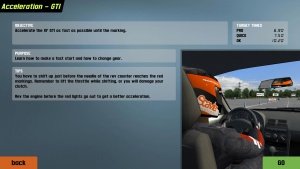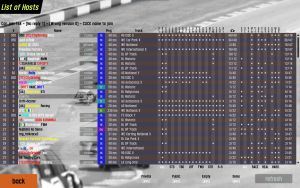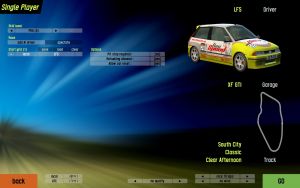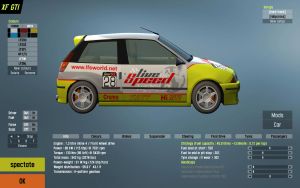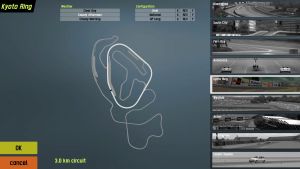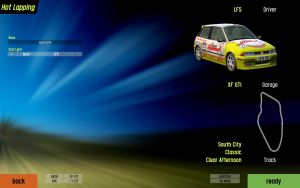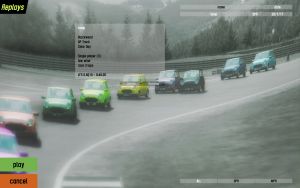Modos de jogo
Treinamento
O novo modo de prática em Live for Speed tem como intenção ser uma escola de direção que irá ajudar todos que são novos no Live for Speed a acostumarem-se com as técnicas de direção necessárias para correr em circuitos. É claro que o modo Treinamento pode ser de grande benefício em refinar o estilo de direção até dos veteranos no Live for Speed. Escolha uma das lições da lista e na tela seguinte você encontrará informação sobre o que deverá fazer para passar no teste. Depois de terminar o exercício, LFS dirá como você se saiu.
Todas as lições devem ser concluídas dentro de um período de tempo e nenhum dos cones pode ser tocado, ou você irá falhar no teste. Clicando no botão Multiplayer te levará para a sua carreira virtual online. Enquanto online você deve sempre lembrar que você está correndo contra oponentes humanos e deve se comportar apropriadamente. Dirija com cuidado e tente evitar acidentes. Driving cleanly não só resultará em melhores corridas - irá também te ajudar a encontrar oponentes que querem correr com você. A maneira mais rápida para começar é clicando em "Mostrar lista de jogos", e escolher um dos vários servidores disponíveis. É claro que há opções adicionais que irão agora ser esclarecidas.
Modo Multiplayer
Menu Principal Multiplayer
Modo Online: This lets you choose if you want to race in Demo, S1 or S2 mode. After choosing Demo, LFS will behave as if it was the locked demo. You will only be able to race the demo cars on the demo tracks and the number of racers will be limited to 11. This option is useful if you want to race a friend who has not (yet) bought LFS. When you create a server while the demo mode is activated, only racers with the demo or racers, who have the demo mode activated as well, will be able to see and join your server. Of course you can switch back to S1 or S2 mode as often as you want without unlocking LFS again.
Modo janela enquanto conecta: Quando esta opção é ativada, LFS irá mudar para o modo de janela enquanto se conecta. Isto é útil quando você precisa manualmente se conectar à internet ou quando você tem um firewall que mostra uma mensagem quando LFS tenta enviar data para o servidor principal. Se o seu computador automaticamente se conecta à internet e LFS está permitido a se conectar com a internet no firewall, você pode é claro desativar esta opção.
Procurar Jogador: Como todo jogador em Live for Speed tem um nome de usuário exclusivo, você pode pesquisar por todo jogador de dentro do LFS. Simplesmente coloque o nome do jogador que você está pesquisando e, se o jogador está online, você será perguntado se quer se juntar a ele no servidor que ele estiver jogando.
Mostrar a lista de servidores
Após clicar neste botão LFS irá se conectar com o servidor principal e baixar a lista de todos os servidores de Live for Speed disponíveis que não estiverem ocultos. A lista contém informação extensa sobre cada servidor incluindo quais carros estão permitidos, qual pista está sendo usada e quantos jogadores estão no servidor no momento. Clicar no botão '?' irá mostrar várias informações adicionas na janela de chat incluindo o nome dos jogadores no servidor. Você pode usar os botões no topo para especificar características especiais de como os servidores serão mostrados.
Filtro de carros: Os filtros de carros te ajudam a encontrar o servidor que você quer.
Método RÁPIDO de usar os filtros: Use os botões de classes dos carros na direita da tela para rapidamente usar vários filtros de carros. TODOS é o valor padrão. Para ajustes mais específicos ou operação manual: Clique no nome dos carros na lista vertical de jogos. Você pode setar eles para CINZA, AZUL ou VERMELHO.
CINZA : Você não se importa se este carro estiver permitido ou não
AZUL : Este carro DEVE estar permitido no servidor
VERMELHO : Este carro NÃO PODE estar permitido no servidor.
Dicas
- Deixe a maioria deles cinza (a cor padrão)
- Os carros que você quer usar, coloque AZUIS
- Use VERMELHO somente para carros que você realmente não quer ver
Clientes : por favor entrem em servidores vazios - mais pessoas irão entrar!!
Servidores : por favor não simplesmente permitam todos carros, mas em vez disso coloque somente um carro ou uma das car classes. Dessa forma o seu servidor conseguirá a melhor experiência para todos os corredores.
Código dos carros: Na lista de servidores você encontrará alguns códigos cryptic que representam os carros permitidos para serem dirijidos no servidor. A lista seguinte contém os carros disponíveis no S2:
UF1 - UF 1000 (S2) XFG - XF GTi (Demo, S1, S2) XRG - XR GT (Demo, S1, S2) XRT - XR GT Turbo (S1, S2) RB4 - RB4 GT (S1, S2) FXO - FXO Turbo (S1, S2) LX4 - LX4 (S1, S2) LX6 - LX6 (S1, S2) FZ5 - FZ 50 (S2) RAC - RaceAbout (S2) MRT - MRT5 (S1, S2) UFR - UF 1000 GTR (S2) XFR - XF GTR (S2) FOX - Formula XR (S2) FBM - Formula BMW FB02 (Demo, S1, S2) FO8 - Formula V8 (S2) BF1 - BMW Sauber F1 (S2) FXR - FXO GTR (S2) XRR - XR GTR (S2) FZR - FZ 50 GTR (S2)
Código das pistas: As pista também são especificadas dentro da lista de servidores usando códigos listados na tabela seguinte. Cada configuração com a exceção das drag strips também pode rodar tanto no layout normal ou direção invertida, efetivamente duplicando o número de pistas. O código da pista é geralmente uma combinação de três partes: 1. Identificador da pista, 2. Número de configuração e 3. Direção (normal/reverso). Por exemplo: BL1R significa "Blackwood GP Reverso", AS3 significa "Aston National", etc.
BL - Blackwood (3 configs: GP, RallyX, Car Park) SO - South City (6 configs: Classic, Sprint 1, Sprint 2, City Long, Town Course, Chicane Route) FE - Fern Bay (6 configs: Club, Green, Gold, Black, RallyX, RallyX Green) AS - Aston (7 configs: Cadet, Club, National, Historic, Grand Prix, Grand Touring, North) WE - Westhill (1 config : International) KY - Kyoto Ring (3 configs: Oval, National, GP Long) AU - Autocross (4 configs: Autocross, Skid Pad, Drag Strip, 8 Lane Drag)
Códigos de informação: Cada servidor na lista tem uma coluna de informações que mostra no geral como o servidor está configurado, usando seis caracteres diferentes para indicar as configurações.
V - Votar (for kick/ban) é permitido S - Selecionar a pista é permitido Q - Qualificação é possível (caso contrário, somente corrida) M - Entrar no meio da corrida é permitido P - Pit stop é obrigatório R - Servidor está conectado ao Insim Relay F - Visão de cockpit obrigatória está ativada no servidor C - Servidor é um servidor de cruise (pode andar na contra mão)
Chat: Quando você clica no botão chat uma janela de chat será mostrada logo acima da lista de servidores. Isto permite que você encontre outros jogadores e combine corridas ou simplesmente converse um pouco. Como em IRC há alguns comandos que você pode usar:
/find [usuário] – isto irá mostrar se o usuário está online no momento assim como o botão 'Encontrar Usuário'.
/users – isto irá mostrar quantos usuários estão online no momento.
/hosts – isto irá mostrar quantos servidores estão online no momento.
/me [texto] – mostra uma ação própria.
/leave – fecha o chat assim como o botão 'Sair'.
/help – mostra a lista com todos os comandos de chat.
Conectar a servidor específico
Esta opção te ajuda a conectar a um servidor específico, por exemplo o servidor de uma equipe ou liga de corridas, sem ter que procurar na lista de servidores. Toda vez que você clicar em 'Conectar a servidor específico', o último servidor que você correu estará presente. Isto permite que você entre novamente em um servidor que você se desconectou a poucos segundos.
Tipo de servidor: Aqui você pode escolher se o servidor é uma sessão LAN ou de Internet. A opção LAN permite até 3 corredores correndo entre sí usando a mesma conta do LFS. Isto permite que seja possível montar pequenas LAN parties mesmo se todos os jogadores não compraram Live for Speed. Dentro do modo demo, a opção LAN também pode ser escolhida quando o IP do servidor é conhecido e você não quer que LFS se conecte ao master server. A opção 'Internet' irá fazer com que LFS automaticamente se conecte ao master server. Desta forma, colocar o nome do servidor é informação suficiente para criar uma conexão mas somente um usuário pode se conectar por vez.
Nome do servidor: Colocar o nome do servidor irá conectar você diretamente com o servidor. Letras maiúsculas e cores são ignoradas.
Senha do servidor: Alguns servidores não são abertos ao público pois eles podem ter propostas específicas como prática de equipes ou eventos de ligas. Estes servidores são geralmente protegidos por uma senha a qual você pode colocar aqui. Vários servidores, mesmo os públicos, tem uma senha de administrador. Se você entrar esta senha de administrador, você poderá alterar certas configurações do servidor usando comandos de chat (veja a lista de comandos). Letras maiúsculas geralmente são ignoradas mas as cores devem combinar.
Endereço IP do servidor: Após escolher LAN como o tipo de servidor, você pode entrar o endereço IP aqui.
Porta do servidor: A porta do srevidor padrão é 63392 e geralmente não precisa ser modificada. Se, por algum motivo, o servidor não use a porta padrão, você pode especificar a porta correta aqui.
Começar novo jogo
É claro que você pode abrir seu próprio servidor no Live for Speed. O número de jogadores que poderão jogar no seu servidor dependem diretamente da velocidade de upload da sua conexão da Internet. O calculador de banda de internet integrado te ajudará a determinar quantos corredores você deveria permitir se conectar. Geralmente há dois tipos diferentes de servidores. O primeiro é o que você roda no seu computador enquanto corre também. O segundo é o chamado servidor dedicado que não oferece gráficos e somente permite outras pessoas a se conectar ao seu servidor. Para ambos os tipos de servidor há várias opções de servidor que podem ser descritas abaixo.
Tipo do servidoor: Isto é praticamente a mesma coisa que 'Conectar-se a jogo específico' mas tem a opção adicionai 'Ocultar'. Um servidor oculto se conectará ao master server mas não ficará visível na lista de servidores dos jogadores. Somente jogadores que sabem o nome exato do servidor poderão se conectar a esse servidor.
Nome do servidor: Isto é o nome do seu servidor, que irá mostrar na lista de servidores, ou se o servidor é oculto, terá que ser manualmente digitado pelos jogadores que querem se conectar.
Senha do servidor: Colocar uma senha nesta linha irá mudar o servidor de público para privado. Somente os jogadores que souberem a senha poderão se conectar. Deixar esta linha vazia irá permitir todos a se conectarem.
Senha de administrador: Entrar uma senha de administrador irá permitir que um administrador remoto se conecte ao servidor LFS. Um corredor que se conectar usando a senha de admin poderá alterar certas configurações do servidor usando comandos do chat.
Endereço IP: Se o servidor tiver mais de um endereço IP você pode especificar qual endereço deve ser usado pelo servidor LFS.
Porta: Especifica qual porta o servidor deve usar para se conectar à Internet. Geralmente isto pode ser deixado ao valor padrão 63392.
CONSELHO: Se o servidor se conecta à internet por um firewall, as portas TCP e UDP que são usadas pelo LFS (63392 e 29339) devem ser modificadas (http://portforward.com/routers.htm) para o servidor.
Conexão de Internet: The optimal maximum number of players on your server depends on the upload bandwidth of your Internet connection. Just choose the correct entry from the list.
Maximum Upload: If the upload bandwidth of your internet connection does not match one of the entries in the list you could choose from under the option 'Internet connection' you can manually enter the correct value here. The value has to be in kBit/s.
ADVICE: If you only know your upload bandwidth in kByte/s or Mbyte/s you will have to convert it to kBit/s:
1 kByte/s = 8 kBit/s
1 MByte/s = 8 MBit/s
Maximum number of Guest PCs: This is the maximum number of PCs that will be allowed to connect to your server. This number does not necessarily match the number of racers that will be able to race on your server.
Maximum cars in race: This is the maximum number of cars that will be allowed to race on your server. This includes human racers as well as the AI.
Maximum cars per guest: This is the maximum number of cars every single guest PC might run on your server. This includes human racers as well as the AI.
Maximum cars on host: This is the maximum number of cars you will be able to race on your server.
Packets per second: Every second all the connected PCs receive data packets from the server which inform them about the positions of all the cars on the track. The more packets per second the PCs receive the more fluent the movement of all the other cars will be and thus the simulation will simply be more immersive. This value determines how many packets per second will be sent which hugely depends on the upload bandwidth of your internet connection. You should always try to keep this value as high as possible.
Dedicated: If you are using a PC to run the server, which does not offer enough 3D performance to properly run LFS in full graphic mode you can choose to run a so called dedicated server which only shows a summary of the connection. You will not be able to directly follow the race but you can still chat with the racers.
Allow vote (Kick/Ban): LFS allows the racers to kick or ban another racer by voting to do so. This has proven to be a good way to prevent people to destroy the races of others on purpose. If this option is set to 'No' only the server administrator will be allowed to kick or ban other racers.
Allow track: If set to 'Yes' this allows the connected to choose the track they want to race on, otherwise only the server adminitrator will be allowed to choose a different track.
Um jogador
Mesmo pensado que o Live for Speed foi desenvolvido para oferecer a melhor experiência de corrida online possível, seu modo de jogador único não é só uma simples adição mas também é bastante importante em diferentes aspectos. Este modo pode ser utilizado para aprender novos tracks, desenvolver setups ou até mesmo praticar ultrapassagens contra a IA. Se você fizer uma besteira no modo de jogador único, você nunca vai deixar ninguém bravo – talvez a si mesmo, possivelmente.
Skill Level: The speed of the AI can be varied from Beginner to Pro. Remember that the AI improves while racing and thus gets faster. On some tracks, the AI might be more than 5 seconds faster after an hour of racing. Every single AI behaves a little different so racing them will never get too boring.
Add AI driver: You can add up to 20 AI drivers to the race.
Join Race: This allows you to enter the race yourself. If you have already added 20 AI drivers to the race, you will not be allowed to join yourself as 20 is the maximum number of racers allowed.
Start Grid: This is a list of all participating drivers. Clicking on a drivers name will select this driver, clicking on the '-' in front of the name will remove the driver from the grid.
Swap Position: This button will only be visible when an AI has been selected from the grid. When you click on this button you will swap position with the selected AI in the grid.
Player: This button directly takes you to the player's options, allowing you to change the name, the driver model you use and your nationality.
Garage: This button takes you to the pits where you can set up and tune your car.
Track: This button lets you choose the track, its configuration, the weather and the time of day.
Laps: The grey buttons allow you to choose how many laps you want to race. Choosing 0 laps will start an unlimited practise session which probably is the best way to learn new cars and tracks as you can do as many timed laps as you want. Additionally, this is the mode that allows you to train your AI over night. As soon as you select 1 or more laps to race, an additional control appears which lets you choose if you want to have a qualifying before the race and how long it should be. Right below the number of laps you can select how much wind you want to have. There are three levels of wind: none, low and strong. The direction and the actual strength is set by a random function.
INFORMATION: The number of laps is limited to a max of 255.
ADVICE: Right-Clicking on the buttons will change the value in steps of 10.
Game Lobby Screen
In the game lobby screen you will set up your single and multiplayer races. Here you can choose your car, including it's skin and setup, the track and set up how long you want to race.
Let’s examine the buttons you can access and their usage. You can see a skill level button labelled pro with an arrow at each end, this button controls the level of intelligence for the AI (Artificial Intelligence) clicking on the left arrow lowers the value, the right increases the value, newbie is the lowest value and starting point, pro is the highest level.
The next button under the skill level is the add AI button this adds a robot car to LFS ready to race against you or against another AI car or the clock; up to twelve AI can race at any one time or eleven AI against you, the racer in offline mode. AI racing is fun and a great way to learn the tracks, racing lines etc., AI can consist of different cars against each other, due to similar outputs and abilities many LFS racers have pitted the GTi against the GT and close racing & great spectator fun has always ensued.
The join race button is self explanatory; this allows you to add your car, manned by you and join in the fun. Looking now to the group of buttons to the right of the screen, we see that the next button is called the player button.
Garage Area and Car Settings
Next we have the main screen you probably will deal with in LFS, this is the garage area, it is here you select your car type, create, add and delete setups and modify all kinds of stuff. Most of these buttons are very easy to figure out and largely self-explanatory, starting from top left we see the car colours panel.
The car colours panel allows you to add, delete and modify the colour schemes of your own prepared skins and some LFS supplied skins. Clicking on the individual colour icon, or using the new button to add a new named skin to the list, from a pop up selection of named skins in the LFS/skins folder.
Under the colour panel is the driver and force panel, this allows you to turn on force lines to show the level of force on the car and add a driver and rotate and bounce the car. Have a play around with it and see the difference stiffer suspension, driver weight, has etc.
The vertical row of buttons (right) contain your car setups for the pictured car type, to change car selection you select the car button. The new button will allow you to make a copy of the currently selected setup, (you then make changes to the new one preserving the original) delete removes the selected setup from the list and LFS.
The most important part on this screen is the horizontal row of car setup buttons, as the naming suggests you can alter the settings of many components here. Info is the only one that cannot be changed, it merely provides info about each car in terms of specifications regarding weight, power output etc.
This whole area has its own separate guide to allow you get the most out of the ability to customise your car for optimum performance and fun. However, briefly, you will notice that all sub menus have sliders to increase or decrease the selected values. Using the sliders you may also right-click on any slider to directly type in the value or you can copy and paste values with Strg-right-click and Shift-right-click respectively.
Make a copy of the default hard track setup by highlighting it, click new to create a copy and save under a different name and play around with the settings by increasing or decreasing items, use small adjustments at first etc, when finished click OK to return to the Single Player screen and add to race by clicking the join race button.
Track Selection
Next we will cover the last button the tracksselection button, pretty important as we need a safe place to race our cars, hey? You will see a small map showing the selected track from an overhead view and details on the overall length of that track, next to the tracks button are buttons that set the type of race at the selected track, the race length and wind speed if any. They are:
Qualifying, this sets the qualifying time in minutes or can be disabled so there is no qualifying for this race race 1, this shows the selected number of laps in the current race, This can be as high as 255 laps or as low as 1 lap, also decreasing the counter to zero sets the session to practice, this is an untimed free session.
Wind has three settings, no wind, low wind and high wind. The wind direction and speed is randomized by LFS and it will have a noticable impact on your laptimes!
There are six major track areas for racing, the sevenths area Autocross is a skid pad zone for building tracks and experimenting, as well as a two and eight lane drag strip area. To use a track, simply select the desired track from the main areas on your right, this will bring a submenu containing all the tracks available for that particular raceway. You can then choose which of the separate tracks to race on by clicking on that track name. A map showing the track layout is then displayed, and options to change the weather conditions (lighting only) are available from the weather menu, with its three options:
BRIGHT CLEAR - OVERCAST - CLOUDY SUNSET/DUSK - You have to make the choice! At this stage of LFS development actual weather conditions, such as rain, hail, fog etc have not been implemented, nor has night racing.
Clicking the OK button will lock in the selected track and options you have chosen and return you to the Single Player selection screen where you can join the race and start racing by clicking the GO button.
Hotlapping
In hotlapping mode you can try to compete with the best drivers in the world without even going online.
This mode puts you on the track in a controlled and perfect environment and lets you fight against the clock. But you should be careful not to leave the road or hit an object while trying to improve your lap times as the HLVC (HotLap Validity Check) will constantly watch what you are doing and mark any lap as invalid which was not clean. In the top right corner of the screen you will see the fastest valid lap you have done and the last split times you did. After you have done a lap that was a personal best and that was marked as valid by the HLVC, you can upload it to http://www.lfsworld.net, compare your time to the official world-record time and see how you rank against all the other racers out there.
Saved replays you can find in data\spr folder. Best way to save replay is to press '1' key, this saves replay file with automatic name in format youraccountname_track_car_time.spr, eg. somebody_AS1_UF1_10883.spr. To name replay file yourself, press '2' key. To upload a replay, open S2 Hotlaps in LFS World, and go to tab Hotlap Charts.
You can access the hotlap database from online game, see 'LFS World statistics commands for in-game usage'.
TIP: Replays of all the laps that have been uploaded to LFS World can be downloaded and then watched on your PC. This is the perfect way to study the racing line of the world's best drivers and improve your own laptimes.
Replays
One of the great features of LFS is the ability to record a replay of each race, whether it be a Single Player Race (SPR) or a Multiplayer Race (MPR, LAN or Online). Watching a replay you can use various camera-perspectives, speed-up, slow-down or even pause the play back. The appropriate hotkeys are listed in the key commands chapter. To record a race it is customary to set this feature in the Options/Game section as we discussed before, however you can save a recorded session by hitting the 2 key on the main keyboard , this saves the race up until that point and immediately starts the saved replay playing back, this is useful when you have just finished an online race and want to save it before everyone restarts.
During a single player replay, if you hit the esc key, you will be presented with some options:
Options: Takes you to main options screen
Replay: Restarts the selected replay
Output lap data: Saves technical information to a .RAF (Replay Analyser File) that you import into external programs, such as LFS Replay Analyser,Analyse For Speed or F1PerfView available from the Live For Speed main site.
Test drive: This allows you to drive using someone’s replay file. Say you dl a World record holders replay and want to see how you do in their car! You may have to change your controller settings to suit if they use a wheel and you use kbd etc .first.
